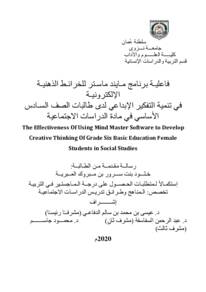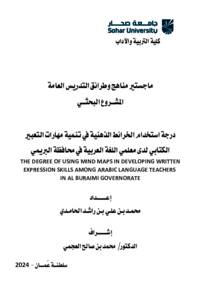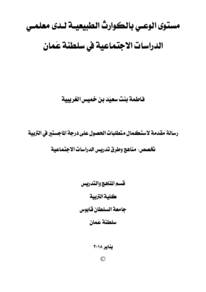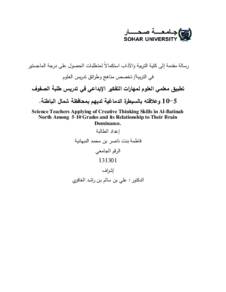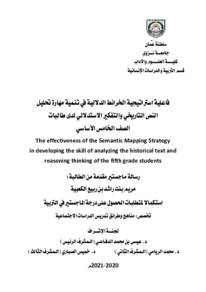Document
فاعليـة برنامج مـايند ماسـتر للخرائـط الذهنيـة الإلكترونيـة في تنمية التفكير الإبداعي لدى طالبات الصف السـادس الأساسي في مادة الدراسات الاجتماعية.
Publisher
جامعة نزوى
Gregorian
2020
Language
Arabic
English abstract
This study aims to explore the extent to which using electronic mind maps is effective in developing creative thinking skills in social studies lessons among grade six female students in the Sultante of Oman. For this purpose, a semi-experimental approach that is based on a pre and post tests was applied. The sample of the study consists of 60 female students in grade six basic education at Tanouf Basic Education School (1-9) in the academic year 2018/2019. The sample of the study is divided into two groups: an experimental group and a control group. Both groups consist of 30 female students each. However, the experimental group was taught using the electronic mind maps strategy while the control group was taught normally in the usual way of teaching. To test the hypothesis of the study, a creative thinking test was applied for both groups.
The study shows the following results:
• There are statistically significant differences at the level of significance (α = 0.05) between the mean scores of the sixth grade students of the experimental and control groups in developing the skill of fluency in the post test.
• There are statistically significant differences at the level of significance (α = 0.05) between the mean scores of the sixth grade students of the experimental and control groups, in the development of the skill of elasticity in the post test.
• There are statistically significant differences at the level of significance (α = 0.05) between the mean scores of the sixth grade students of the experimental and control groups, in developing the skill of originality in the post test.
Based on these results, the study came up with many significant recommendations and the most important ones are the following. First, social studies teachers should employ mind mapping softwares in their lessons. Second, further similar studies in other subjects and grades should be conducted to improve the teaching and learning experience for students.
Member of
Resource URL
Arabic abstract
هدفت الدراسة إلى تقصي فاعلية التدريس بالخرائط الذهنية الإلكترونية في تنمية مهارات التفكير الإبداعي لدى طالبات الصف السادس الأساسي في مادة الدراسات الاجتماعية بسلطنة عُمان.
وتحقيقاً لهذا الهدف تم استخدام المنهج شبه التجريبي القائم على التصميم (القَبْلِي – البَعْدِي) لمجموعتين متكافئتين، وتكونت عينة الدراسة من (60) طالبة من طالبات الصف السادس الأساسي للعام الدراسي 2018/2019م بمدرسة تنوف للتعليم الأساسي (1-9) مقسّمة إلى مجموعتين: مجموعة تجريبية قوامها (30) طالبةً، دُرِّست باستخدام استراتيجية الخرائط الذهنية الإلكترونية، والأخرى ضابطة عددها (30) طالبة دُرِّست بالطريقة الاعتيادية، ولاختبار فرضيات الدراسة طُبِق اختبار التفكير الإبداعي.
أظهرت الدراسة النتائج الآتية:
وجود فرق دال إحصائياً عند مستوى الدلالة (0.05=α) بين متوسطي درجات طالبات الصف السادس الأساسي للمجموعتين التجريبية والضابطة، في تنمية مهارة الطلاقة في القياس البعدي.
وجود فرق دال إحصائياً عند مستوى الدلالة (0.05=α) بين متوسطي درجات طالبات الصف السادس الأساسي للمجموعتين التجريبية والضابطة، في تنمية مهارة المرونة في القياس البعدي.
وجود فرق دال إحصائياً عند مستوى الدلالة (0.05=α) بين متوسطي درجات طالبات الصف السادس الأساسي للمجموعتين التجريبية والضابطة، في تنمية مهارة الأصالة في القياس البعدي.
وفي ضوء هذه النتائج أوصت الدراسة بمجموعة من التوصيات ومن أهمها: توظيف المعلمين لبرامج الخرائط الذهنية الإلكترونية في تدريس مادة الدراسات الاجتماعية، وإجراء مزيداً من الدراسات الأخرى المشابهة في مواد ومراحل دراسية أخرى.
وتحقيقاً لهذا الهدف تم استخدام المنهج شبه التجريبي القائم على التصميم (القَبْلِي – البَعْدِي) لمجموعتين متكافئتين، وتكونت عينة الدراسة من (60) طالبة من طالبات الصف السادس الأساسي للعام الدراسي 2018/2019م بمدرسة تنوف للتعليم الأساسي (1-9) مقسّمة إلى مجموعتين: مجموعة تجريبية قوامها (30) طالبةً، دُرِّست باستخدام استراتيجية الخرائط الذهنية الإلكترونية، والأخرى ضابطة عددها (30) طالبة دُرِّست بالطريقة الاعتيادية، ولاختبار فرضيات الدراسة طُبِق اختبار التفكير الإبداعي.
أظهرت الدراسة النتائج الآتية:
وجود فرق دال إحصائياً عند مستوى الدلالة (0.05=α) بين متوسطي درجات طالبات الصف السادس الأساسي للمجموعتين التجريبية والضابطة، في تنمية مهارة الطلاقة في القياس البعدي.
وجود فرق دال إحصائياً عند مستوى الدلالة (0.05=α) بين متوسطي درجات طالبات الصف السادس الأساسي للمجموعتين التجريبية والضابطة، في تنمية مهارة المرونة في القياس البعدي.
وجود فرق دال إحصائياً عند مستوى الدلالة (0.05=α) بين متوسطي درجات طالبات الصف السادس الأساسي للمجموعتين التجريبية والضابطة، في تنمية مهارة الأصالة في القياس البعدي.
وفي ضوء هذه النتائج أوصت الدراسة بمجموعة من التوصيات ومن أهمها: توظيف المعلمين لبرامج الخرائط الذهنية الإلكترونية في تدريس مادة الدراسات الاجتماعية، وإجراء مزيداً من الدراسات الأخرى المشابهة في مواد ومراحل دراسية أخرى.
Category
Theses and Dissertations

